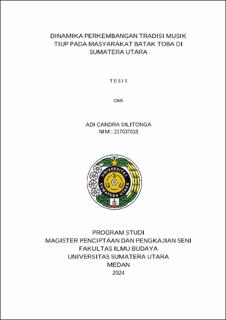Dinamika Perkembangan Tradisi Musik Tiup pada Masyarakat Batak Toba di Sumatera Utara
The Dynamics of The Development of Traditions “Musik Tiup” at Toba Batak Community in North Sumatra

Date
2024Author
Silitonga, Adi Candra
Advisor(s)
Purba, Mauly
Ginting, Pulumun P
Metadata
Show full item recordAbstract
This research examine the “Musik Tiup” tradition of the Toba Batak community in North Sumatra. The discussion includes the dynamics of the development of function, context, reportage, and instrumentation of the “Musik Tiup” tradition. The understanding of wind music ensembles is emicly varied from the formation of instruments, some understand that wind music is an ensemble consisting ofalto saxophone, tenor saxophone, trumpet, trombone, tuba, bass drum andsnare drum. Another understanding of wind music is mergingelectric guitar, electric bass, keyboard, drum kit, trumpet and saxophone. Therefore, the understanding of wind music in the Toba Batak community should be understood by paying attention to the context, meaning that wind music is a term that differentiates the ensemble from the ensemble. Gondang Sabangunan and Gondang Hasapi. In the 1980s, the use of wind music, which was initially only used in religious contexts, developed to replace the functionGondang A match andGondang Hasapi in the context of traditional ceremonies, because religious followers who are also traditional practitioners want to be free from negative assumptions as adherentsin the beginning. On the other hand, the use of wind music is also considered more practical in comparison Gondang Sabangunan to bring it about there are norms that must be fulfilled. This phenomenon contributes to the new musical identity of the Toba Batak people, the process of change, adjustment and development is an interesting thing to study. Through this research, the author will discuss the dynamics of the Toba Batak Wind Music Tradition in 3 periods, namely starting from the colonial period (1860s to 1942), then the Toba Batak Migration period (1930-1954), and finally from 1950 until now.
